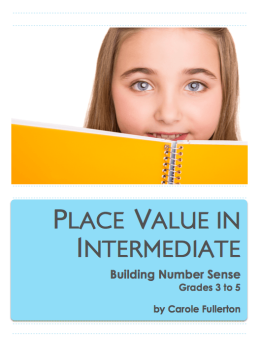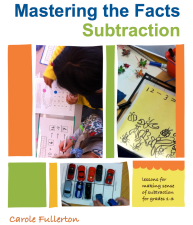New Resource! Place Value For Intermediate (Grades 3 to 5)

Phew! This one has been a long time in coming… :o)
My sincere appreciation to all of you who have waited for the publication of this book. As you know, I’ve had a pretty remarkable year. I hope you’ll forgive me, knowing that only good distractions delayed its completion!
But I am pleased as punch to announce the release of Place Value For Intermediate: Building Number Sense for Grades 3-5, available now from my online store for $50.
This resource for teachers of Grades 3 through 5 features lessons designed to support deep learning of number. A wide range of both open-ended and directed tasks focus on representing, describing, comparing and ordering numbers to 100 000, as well as explorations of decimal numbers to thousandths.
Measurement experiences make up a big part of this series of tasks. The metric system and all of its place value connections is featured in explorations of linear measurement (mm, cm, m, km), perimeter (cm, mm), area (square cm and square m), mass (g, kg) and capacity (mL, L).
Addition and subtraction of large numbers and decimals are also addressed in this volume. Lessons at the grades 4 and 5 level focus on multiplication of 1 by 2- and 3-digit factors as well as 2 by 2-digit factors using the distributive property (an area model).
Assessment tasks tap into students’ understandings of these numbers and their application in the real world. Being able to see and relate to big numbers and to very small ones, to understand their relative size and to capably use these numbers to estimate is the essence of number sense.
Set up in a developmental continuum intended to facilitate the teaching of combined grades, this 352 page volume is certain to contain material to meet the needs of all learners and to inspire fun and engagement with critically important place value concepts.
When you buy the book online, you also get access to almost 40 pages of digital files and resources, which will be emailed to you as a downloadable pdf!
Thanks for your continued support and inspiration…
Enjoy!
Carole
Calculation Nation – Rich, online math games for practice
The NCTM (National Council of Teachers of Mathematics) has a set of online math resources worth looking into. Check out Calculation Nation (calculationnation.nctm.org/) for a series of challenging and engaging games for students in grades 3-9. Students will explore factors, prime and composite numbers, multiplication, area and perimeter, operations on fractions, solving algebraic equations and geometric concepts like tessellations and symmetry. Students can play these games against the computer or even against another player somewhere else in the world!
A simple log in is all that’s required in order to play.
I’m sure you’ll find some worthwhile tasks in this set of carefully crafted materials. Enjoy!

Explaining the derivation of the Area of a Circle – Grade 7
So… we all know that the formula of the area of a circle is  .
.
But have you ever considered why? Students in Grade 7 need to understand the derivation of this formula and apply it to different situations. My husband sent me these awesome on-line demonstrations of how the area of s circle is derived, using what we know about triangles. Consider these images and what they show. First, the circle is chopped up into roughly triangular segments.

They are put together to form a parallelogram, in which the base is 1/2 of the circumference of the original circle.

The height of the parallelogram is the same as the radius of the circle (since each of the triangles is a section of the original circle).
To find the area of the parallelogram, we multiply the base times the height, or 1/2 of the circumference of the circle x the radius of the circle. Consider it in this more abstract language:
1/2 (  ) r which simplifies to
) r which simplifies to 
Cool, huh?
It’s WAY more effective to watch the video of the event. Check it out here!
Carole
PS – There’s another derivation that draws on the area of a triangle… I won’t wreck it for you, but consider this… The base of the large triangle here is the whole circumference of the circle, or 2πr. Each of the little triangles that make it has a height the same as the radius of the original circle. So that means that the area of this large circle is 1/2 base x height, or 1/2 (2πr) x radius/ Familiar?










